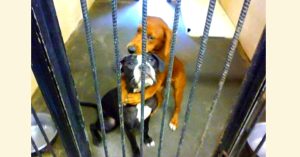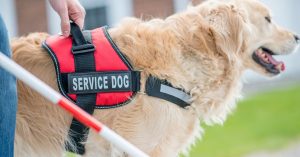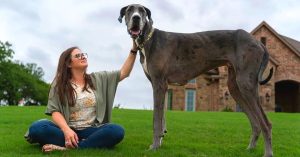Embark on a journey through the world of canine athleticism with our eye-opening guide to the most athletic dog breeds.
While some breeds are renowned for their physical prowess, others might catch you off guard with their surprising agility and strength.
Dive into this fascinating exploration to discover which breeds top the list – some of the names may indeed surprise you!
Border Collie
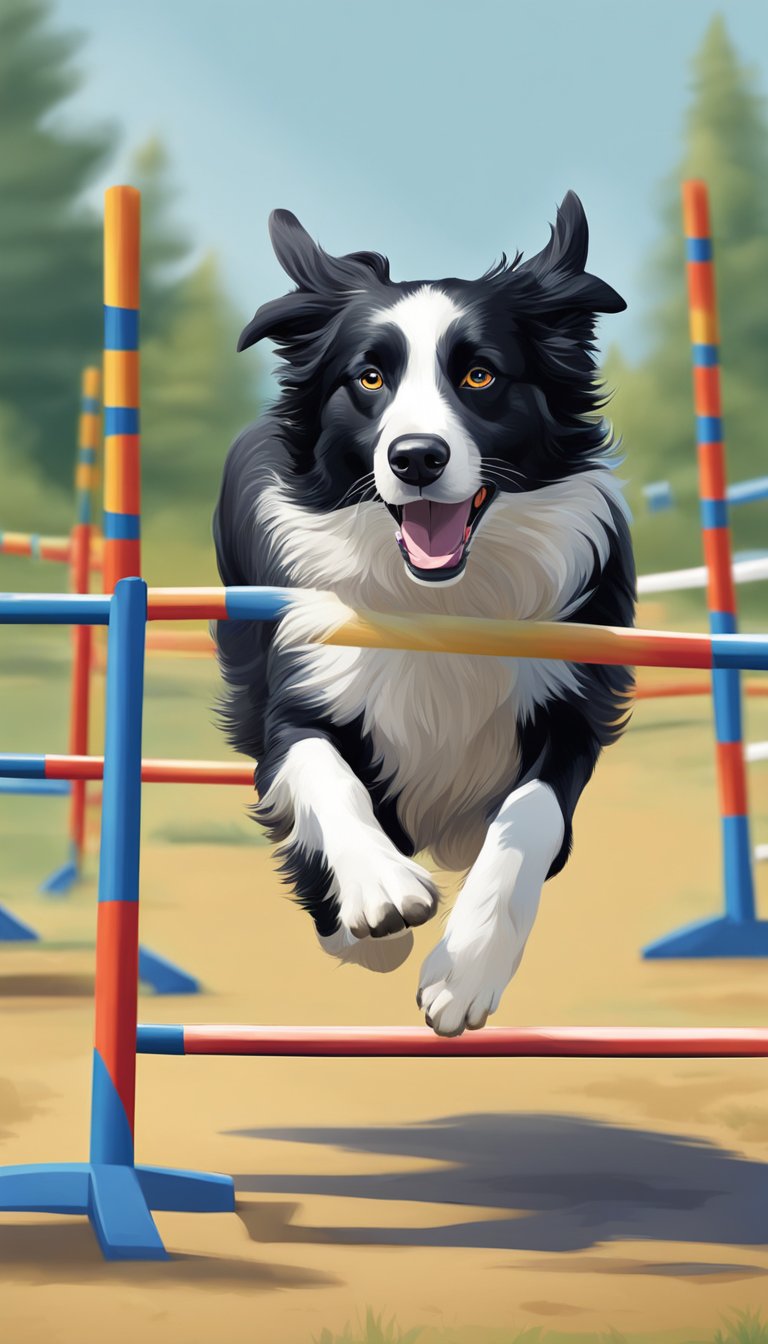
The Border Collie is renowned for its exceptional intelligence and versatility, consistently ranking as one of the most athletic dog breeds.
Originally bred for herding sheep on the Scottish borders, this breed exhibits remarkable agility and energy levels that are essential for intensive tasks.
Characteristics:
- Intelligence: Highly trainable and often considered the smartest of all dog breeds.
- Physicality: Muscular build that excels in agility-related activities.
Ideal Activities:
- Herding: Their instinct and quick reflexes make them natural herders.
- Dog Sports: Competitions like flyball and disc games.
- Obedience: They learn commands quickly and accurately.
- Search and Rescue: A keen sense of smell and a strong work ethic.
Given their need for mental and physical stimulation, Border Collies thrive in environments where they can engage in various activities.
They are often utilized as working dogs due to their ability to learn a wide range of tasks and their eagerness to please their handlers.
Their coat is generally medium-length, which can come in several color patterns, including the distinctive black and white.
Care Considerations:
- Exercise: They require ample daily exercise to satisfy their energy.
- Mental Stimulation: Puzzle toys and advanced training can keep their intellect engaged.
Owners of Border Collies should be prepared for an active lifestyle to meet the breed’s needs.
They’re suited for individuals or families who enjoy outdoor activities and can provide a structured environment for the dog to flourish.
Australian Shepherd
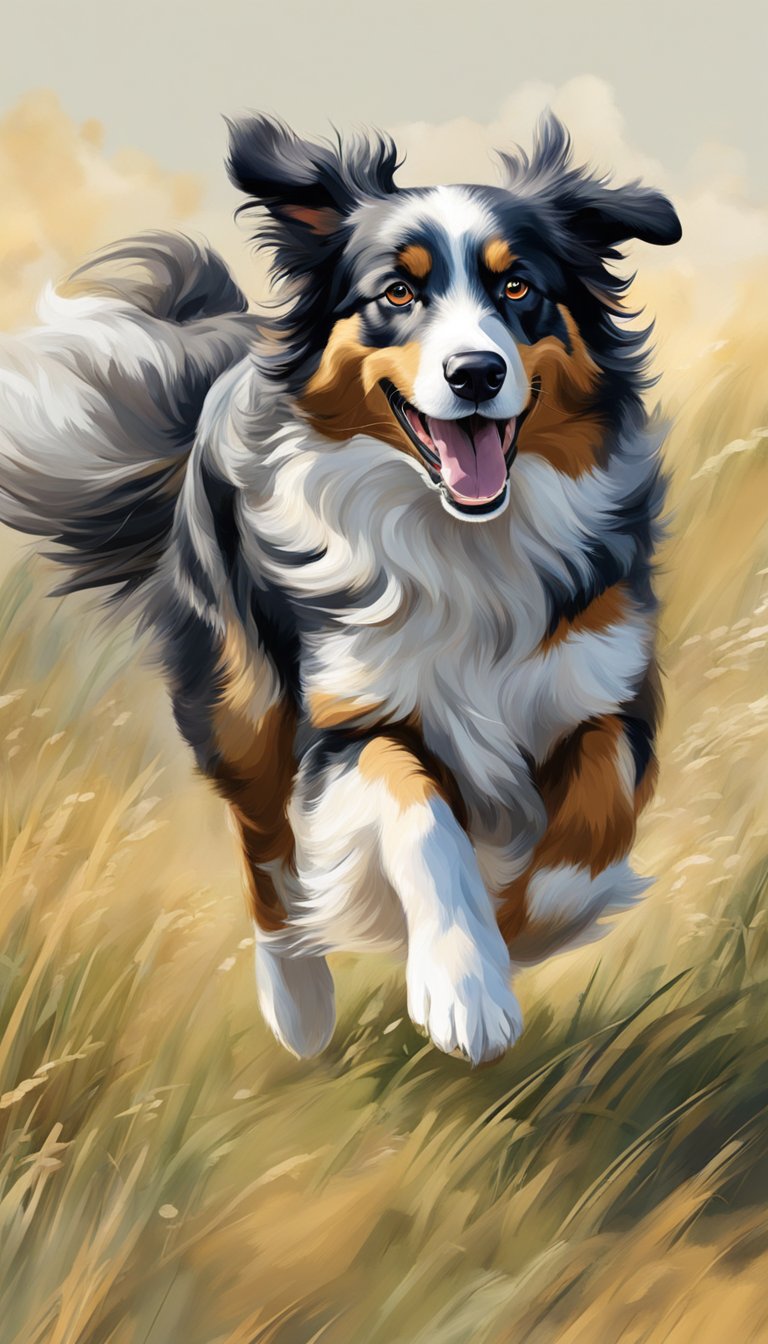
The Australian Shepherd, commonly known as the Aussie, is a breed celebrated for its athleticism and eagerness to work.
Originally bred to herd livestock, they exhibit high levels of energy and require substantial daily exercise to remain content and healthy.
Physical Attributes:
- Size: Medium to large
- Coat: Moderate to long length, weather-resistant
- Color Variations: Blue merle, black, red merle, and red – all with or without white markings and/or tan points.
Exercise Needs:
- Activity Level: High
- Exercise Requirements: At least 1-2 hours per day
Health & Lifespan:
- Life Expectancy: 12-15 years
- Common Health Concerns: Hip dysplasia, epilepsy, and certain vision problems
The breed excels in various dog sports, including agility, obedience, and herding trials.
Their intelligence and trainability make them a preferred choice for active individuals and families who participate in outdoor activities.
The Australian Shepherd’s herding instinct can also translate into a propensity for chasing moving objects, underlining the importance of a secure, fenced area for exercise.
Socialization and training starting from a young age are crucial in harnessing their energy and potential.
Their loyalty and protective nature make them attentive companions, but this also means they may be reserved around strangers without proper socialization.
The Australian Shepherd’s coat requires regular maintenance, including weekly brushing to prevent matting and to manage seasonal shedding.
Siberian Husky
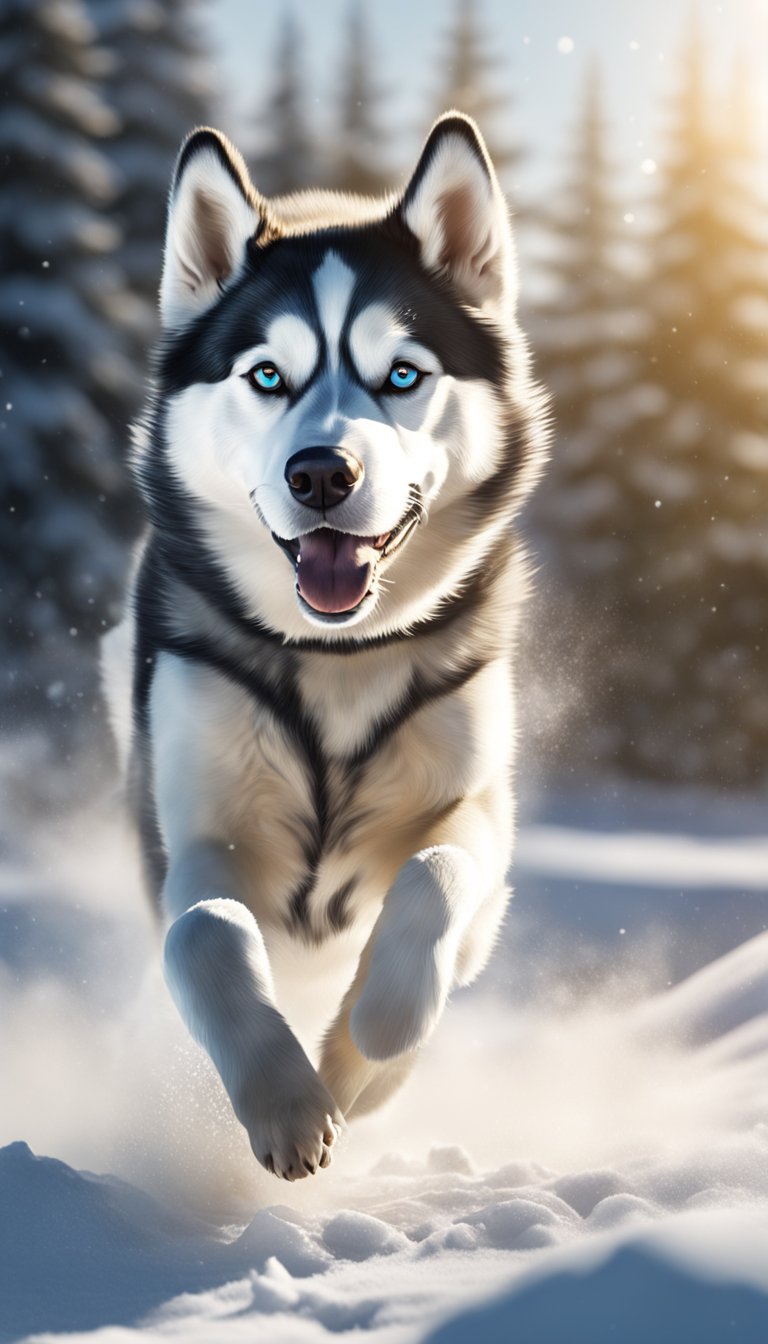
The Siberian Husky is a medium-sized working dog with a thick coat, known for its endurance and ability to work in packs.
Its history as a sled dog in the harsh Siberian Arctic has endowed it with incredible stamina and an eagerness for activity.
Key Characteristics:
- Size: Medium
- Coat: Dense double coat
- Colors: Variety, including black, grey, and red
Physicality:
The breed’s body is compact and well-muscled, an adaptation for its original purpose of pulling light loads over expansive snowy terrains at moderate speeds.
They possess a distinctive wolf-like appearance, which adds to their allure.
Temperament:
Siberian Huskies are known for their friendly disposition and sociable nature. Despite their strong work ethic, they often exhibit a playful attitude and enjoy activities with their human counterparts. They have a strong pack mentality and tend to get along well with other dogs.
Exercise Needs:
These dogs require ample daily exercise to match their energy levels.
- Daily vigorous exercise
- Activities that stimulate both their mind and body
Siberian Huskies are escape artists; a secure, fenced yard is crucial to keep them safe when they’re not on a leash.
Care:
Regular grooming is essential to manage their shedding, especially during the bi-annual “blow” of their undercoat.
Despite their thick fur, Siberian Huskies are relatively clean and free of doggy odor.
The Siberian Husky remains one of the most popular athletic dog breeds, loved for its elegance, efficiency, and amiable nature.
Jack Russell Terrier
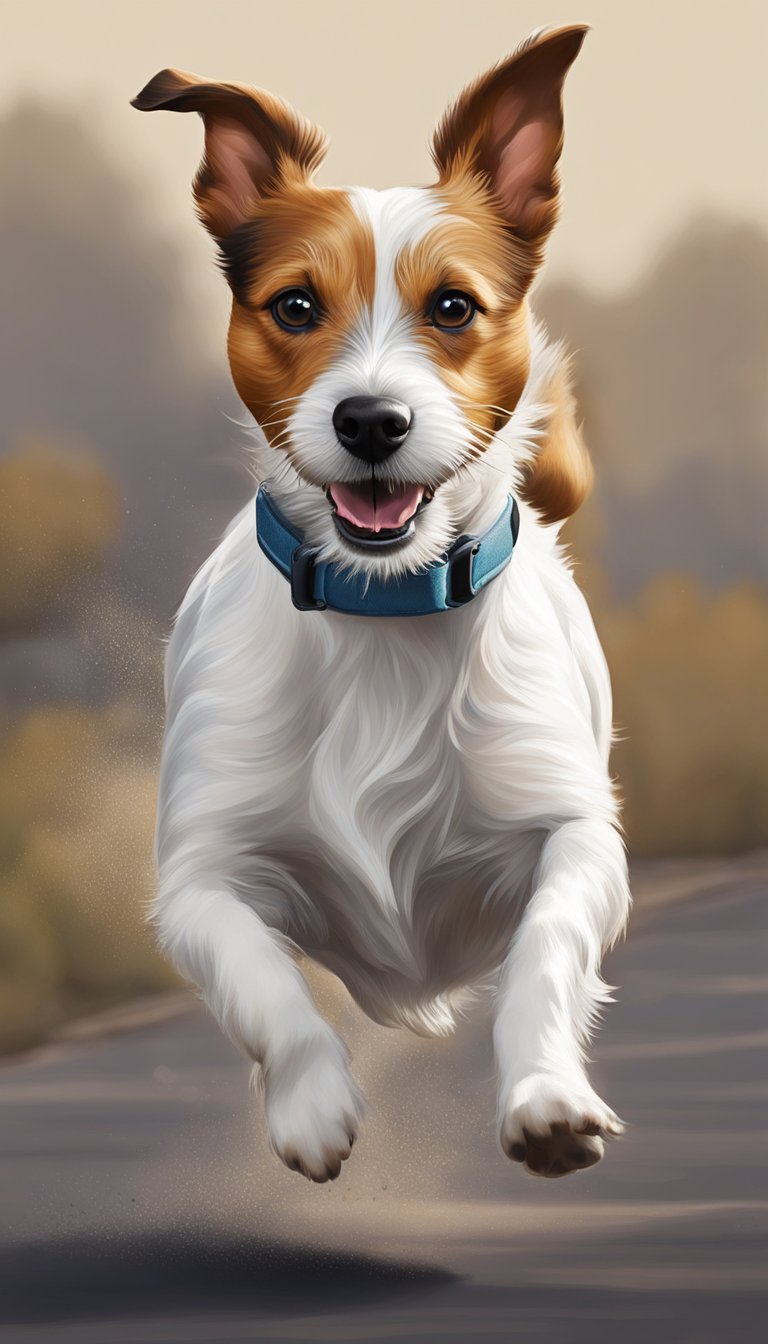
The Jack Russell Terrier is a breed well-known for its vitality and athleticism.
Originating from England, the breed was initially developed for fox hunting, and these roots contribute to its remarkable agility and energy levels.
Size and Build
Typically standing around 10 to 15 inches tall at the shoulder, they are compact and muscular, characterizing a small but powerful physique perfect for vigorous activities.
Typically standing around 10 to 15 inches tall at the shoulder, they are compact and muscular, characterizing a small but powerful physique perfect for vigorous activities.
Energy and Stamina
They possess a seemingly endless well of energy, making them excellent companions for active lifestyles.
Their stamina enables them to partake in long sessions of play and exercise, thriving in environments where they can burn off energy.
Character and Training
- Intelligent: Jack Russell Terriers are exceptionally smart, which aids in trainability if consistent methods are applied.
- Independent: Their independent streak requires a patient and firm owner.
- Eager to Please: They ideally enjoy learning and pleasing their owner, which can be leveraged in training.
Exercise Needs
Their exercise needs are substantial, and they crave activities such as:
- Fetch
- Frisbee
- Agility Competitions
To meet their physical needs, they should be provided with ample opportunities to run, jump, and play.
Vizsla
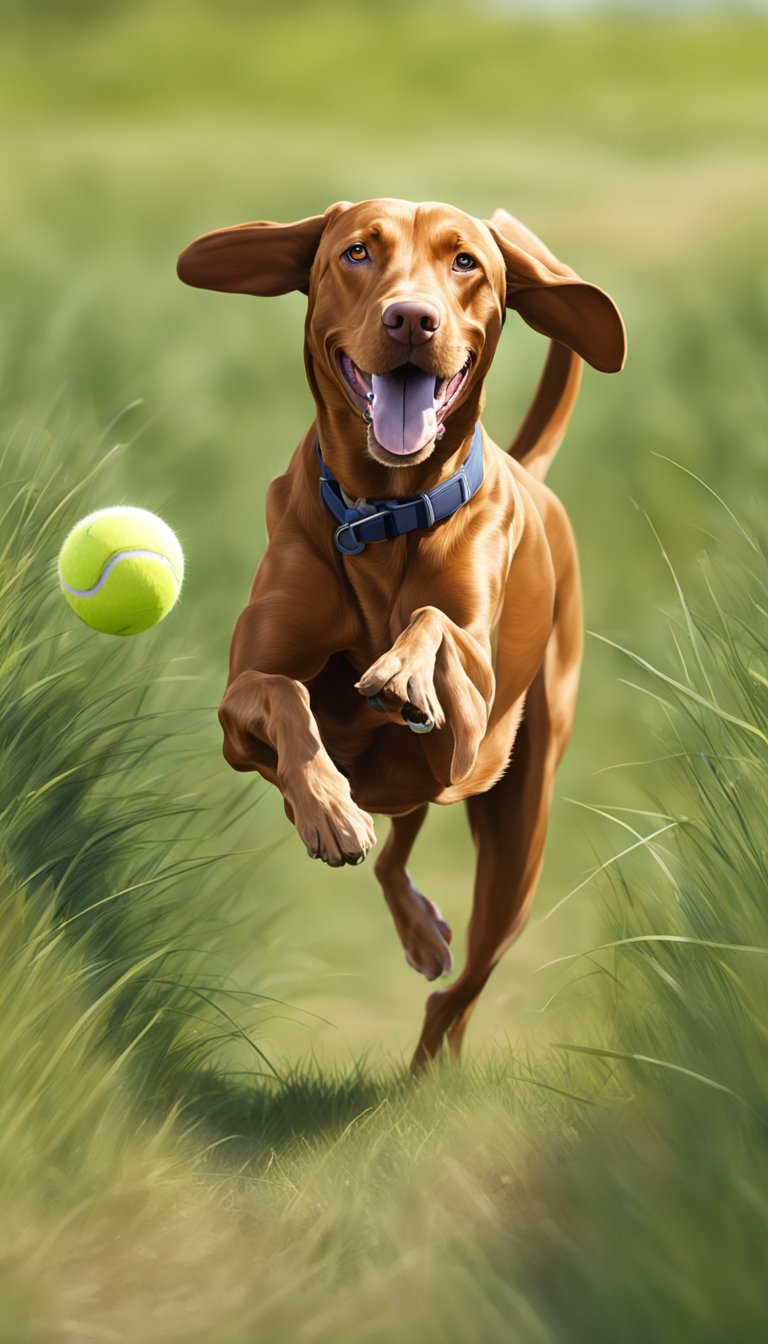
The Vizsla, often known as the Hungarian Pointer, is a highly athletic breed renowned for its energy and agility.
Originally bred in Hungary for hunting, these dogs display remarkable stamina and a strong desire to work alongside their human companions.
Height and Weight of the Vizsla:
- Males: 22 to 24 inches tall, 55 to 60 pounds
- Females: 21 to 23 inches tall, 44 to 55 pounds
Characteristic of the breed is their smooth, short coat that is golden-rust in color, a unique hue that distinguishes the Vizsla.
Not only is their coat attractive but also low maintenance, requiring just a weekly brush to minimize shedding.
Vizslas possess an amiable temperament. They’re known for their friendliness and form strong bonds with their families.
However, they’re not just sociable – they also require significant mental and physical exercise.
A typical Vizsla needs a “job” or engaging activities daily to stay healthy and happy. This can involve:
- Physical Activities: Running, hiking, or agility training
- Mental Stimulation: Interactive games or obedience training
In the absence of adequate exercise, they may resort to destructive behavior due to their innate energy levels.
Therefore, it’s essential for potential Vizsla owners to ensure they can commit to the dog’s active lifestyle needs.
They thrive with owners who have a similar athletic lifestyle and can often be seen excelling in various dog sports.
Weimaraner
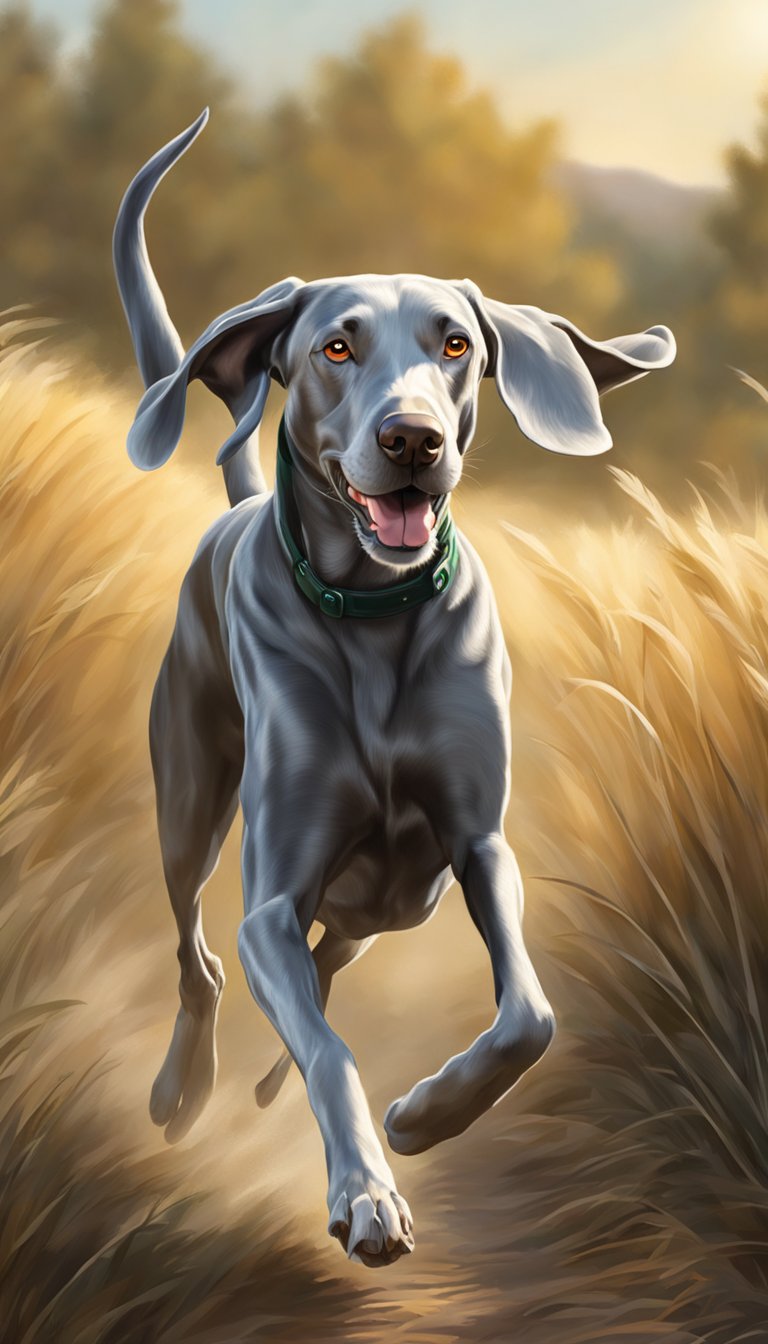
The Weimaraner, a sporting dog breed from Germany, is renowned for its athletic prowess and distinctive appearance. Here’s what enthusiasts and potential owners should know:
- Coat: They sport a uniform steel gray coat.
- Eyes: Their soulful eyes are often a shade of blue.
- Ears: This breed is also known for oversized floppy ears.
Exercise Needs
Weimaraners were bred for hunting, requiring ample exercise. They are happiest when they have a job to do or space to run, making them perfect companions for active families.
Temperament
- Friendly: Known to be affable with their family.
- Fearless: They exhibit boldness in their actions.
- Alert: This trait makes them suitable as watch dogs.
Health
Potential owners should be aware that Weimaraners can be predisposed to certain genetic conditions. Regular vet check-ups and a healthy lifestyle can help mitigate these risks.
Intelligence
- Trainability: They love to learn and respond well to training.
- Canine Sports: Excelling in sports like agility due to their intelligence and energy.
Social
Weimaraners are sociable and commonly described as good with families, thriving in a home environment where they can form strong bonds with their owners.
Belgian Malinois

The Belgian Malinois is renowned for its incredible athleticism and intelligence.
Originating from Belgium, this herding breed demonstrates a remarkable combination of strength and agility, making them frequent participants in dog sports such as agility and obedience.
Size:
- Males: 24 to 26 inches at the shoulder
- Females: 22 to 24 inches
Weight:
- Males: Heavier than females
- Females: Generally weigh less than males
Characteristics: Belgian Malinois possess a short, weather-resistant coat and often appear in fawn to mahogany colors with black markings.
Their alert and expressive faces, crowned with erect ears, reflect their keen attentiveness.
Belgian Malinois thrive with regular physical activity and mental stimulation.
They form strong bonds with their owners, who should be prepared to provide them with plenty of exercises and engagement.
Potential owners should also be aware of the breed’s herding instincts, which can manifest as chasing or moving behaviors, especially without appropriate training and socialization.
Health and Lifespan:
- Average lifespan of 12 to 14 years
- Typically healthy, but like all breeds, can be susceptible to certain hereditary conditions
Those considering a Belgian Malinois must remember the commitment required to match this breed’s energy levels.
They are ideally suited for active individuals or families who can incorporate the dog into regular activities and provide structured training.
In the right environment, a Belgian Malinois makes a loyal and high-spirited companion.
Greyhound

The Greyhound is one of the oldest dog breeds in the world, with a heritage that traces back thousands of years.
Originally bred for hunting due to its remarkable speed, the Greyhound has maintained a reputation for being an active and athletic breed.
Physical Attributes:
- Speed: Capable of reaching up to 45 miles per hour, the Greyhound is the fastest dog breed.
- Build: It has a slender, streamlined body with a deep chest and long, powerful legs.
- Coat: Greyhounds possess a short coat that is easy to maintain and can come in a variety of colors.
Exercise Needs:
- High Energy: They require regular exercise to stay healthy and happy.
- Space to Run: A large, safe area where they can sprint is ideal for Greyhounds to exercise properly.
Temperament:
- Generally, Greyhounds are known for their gentle and intelligent nature.
- Despite their athletic prowess, they are often surprisingly good-natured and calm indoor companions.
Greyhounds are not just athletes; they also make affectionate pets. After they retire from racing, many Greyhounds are adopted and adapt well to home life, demonstrating a laid-back disposition.
They are social creatures that enjoy the company of humans and other dogs.
However, their strong prey drive means they may not be well-suited to a household with smaller pets, such as cats or rabbits.
When adopting a Greyhound, one should be prepared for a committed exercise schedule and understand that this breed thrives with space to unleash its remarkable speed.
Labrador Retriever
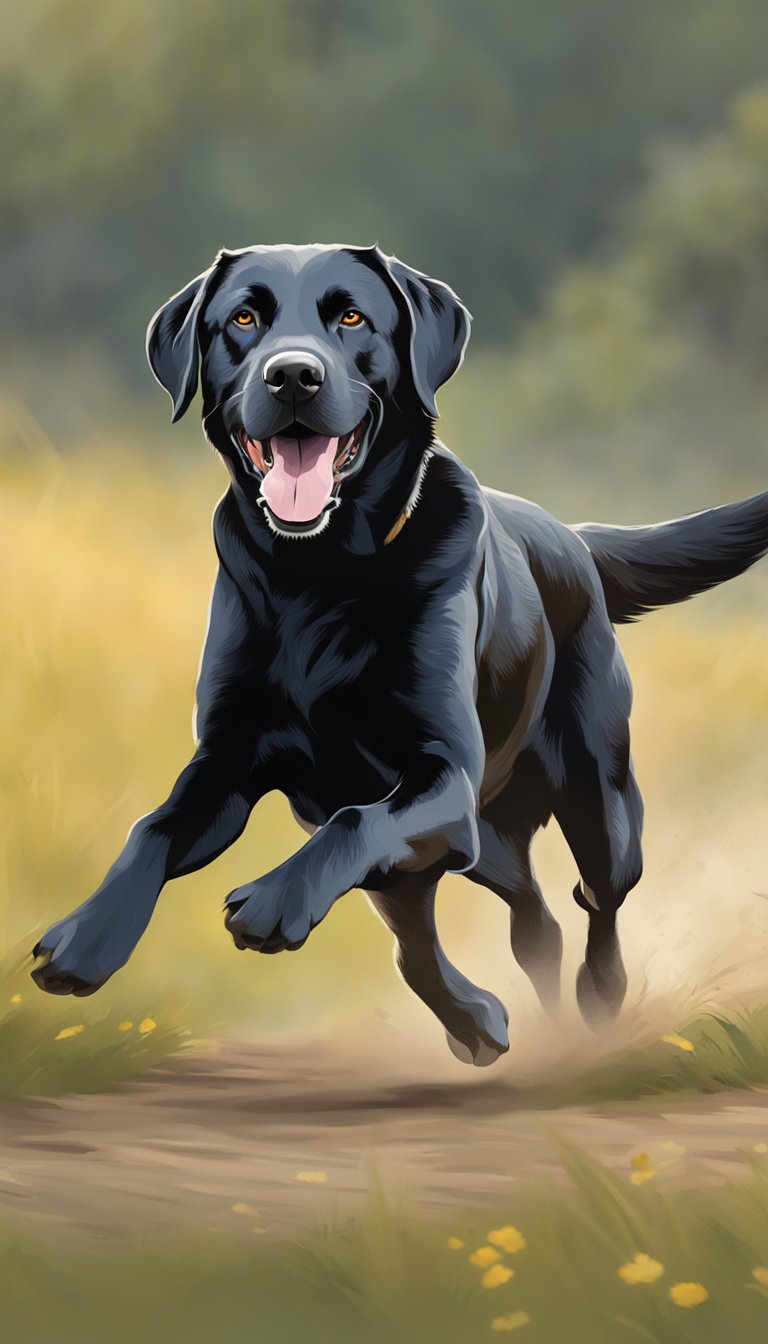
Originating from Newfoundland, not Labrador as the name might suggest, the Labrador Retriever was initially bred to help fishermen retrieve nets and fish that had escaped hooks.
They have since become one of the most popular dog breeds in the United States and many other countries.
Size and Build:
Labradors are medium to large dogs with a sturdy, athletic build. On average, males weigh between 65 and 80 pounds, with females typically weighing 10-15 pounds less.
Energy Level:
Labrador Retrievers have copious amounts of energy that make them excellent companions for active individuals or families.
They are often described as outgoing and are well-known for their love of water and natural retrieving abilities, which can be harnessed in various dog sports.
Exercise Requirements:
- Regular vigorous exercise
- Activities like swimming, fetching, and agility training are beneficial
Temperament:
Labrador Retrievers have a friendly and patient temperament, often making them great family pets. Their intelligence and eagerness to please also make them highly trainable.
| Trait | Description |
|---|---|
| Energy Level | High |
| Size | 65-80 pounds (males), 55-70 pounds (females) |
| Exercise Needs | High; includes mental and physical stimulation |
| Affinity for Water | Very high; loves swimming |
| Trainability | High; intelligent and eager to please |
Labradors do require proper mental and physical exercise to maintain their health and happiness.
Without adequate activity, they may resort to undesirable behaviors out of boredom.
As such, they are best suited for individuals or families willing to invest time in their exercise and training.
German Shepherd
The German Shepherd is a breed known for its versatility and athleticism.
They are often seen working in various roles such as police and military service, search and rescue, and as loyal companions.
Size and Build:
- Height: Males 24-26 inches, Females 22-24 inches
- Weight: Males 65-90 pounds, Females 50-70 pounds
Their muscular body and strong frame make them well-suited for demanding physical tasks.
Activity Level:
- German Shepherds are high-energy dogs that require regular exercise. Daily activities could include long walks, runs, or agility training.
Intelligence:
- They are highly intelligent and trainable. This breed excels in obedience and is known for its quick learning ability, making them ideal for various canine sports.
Temperament:
- They are loyal and protective, often forming a strong bond with their family.
- Socialization is important for German Shepherds to ensure they are well-adjusted and confident.


